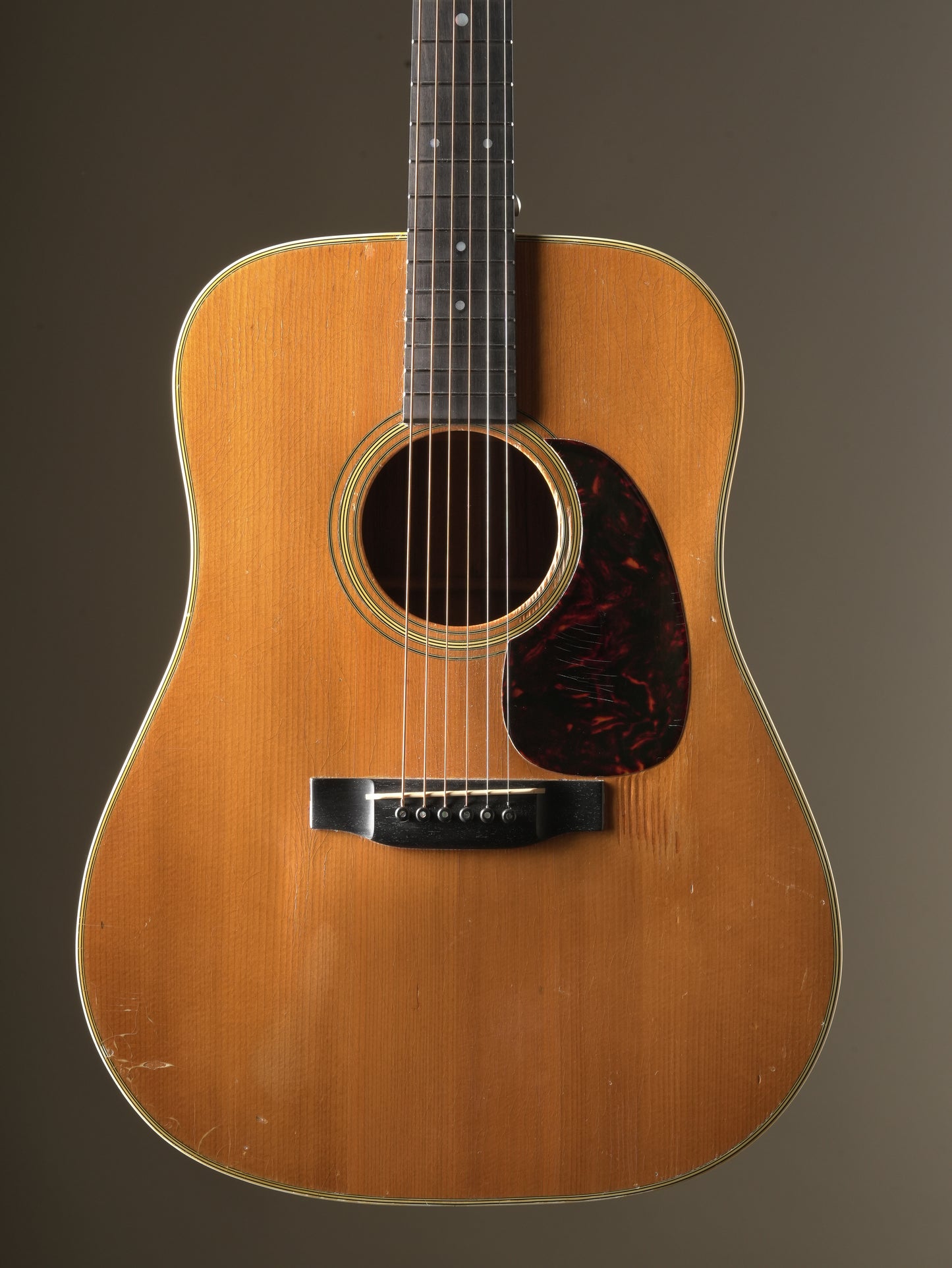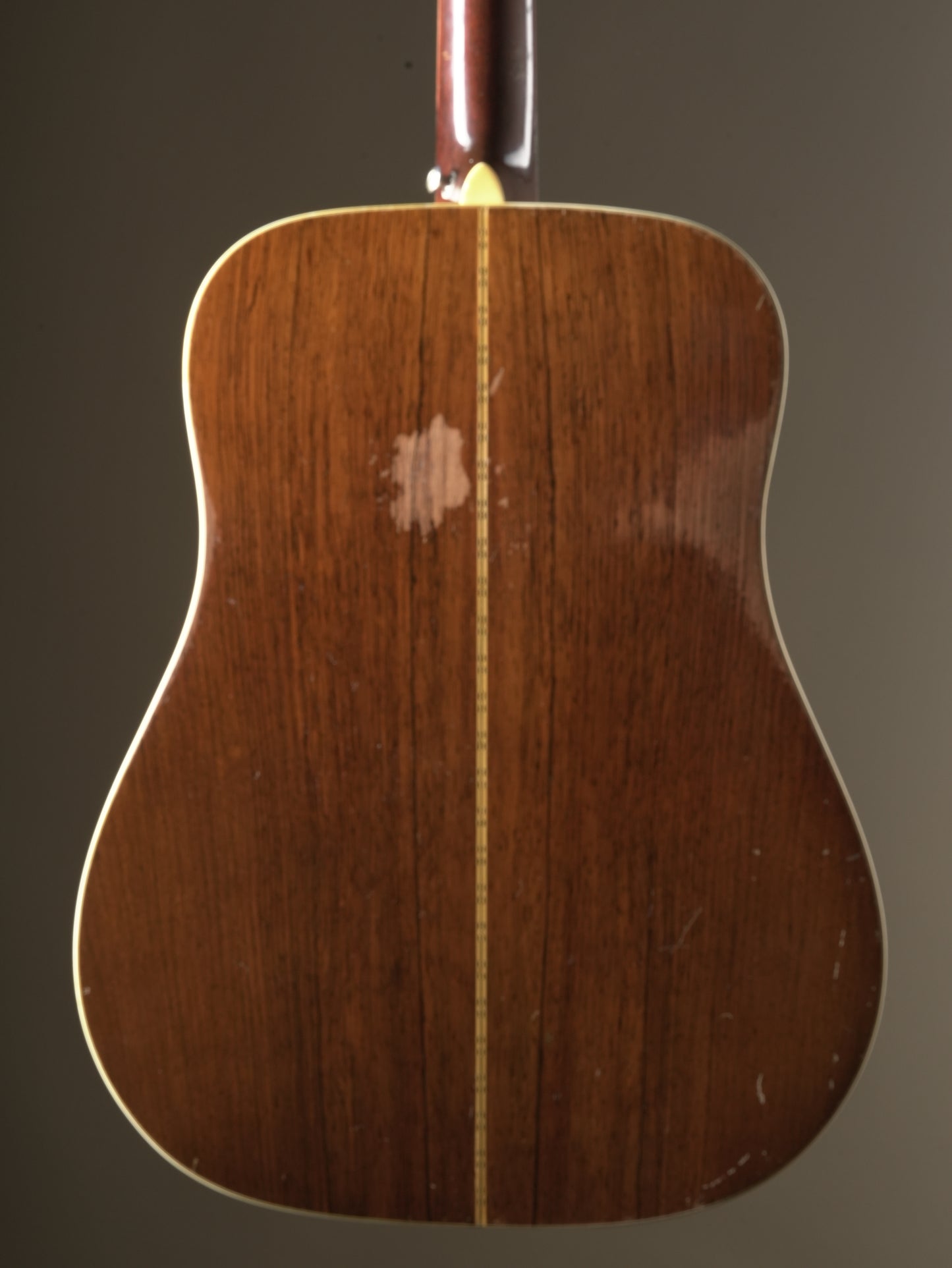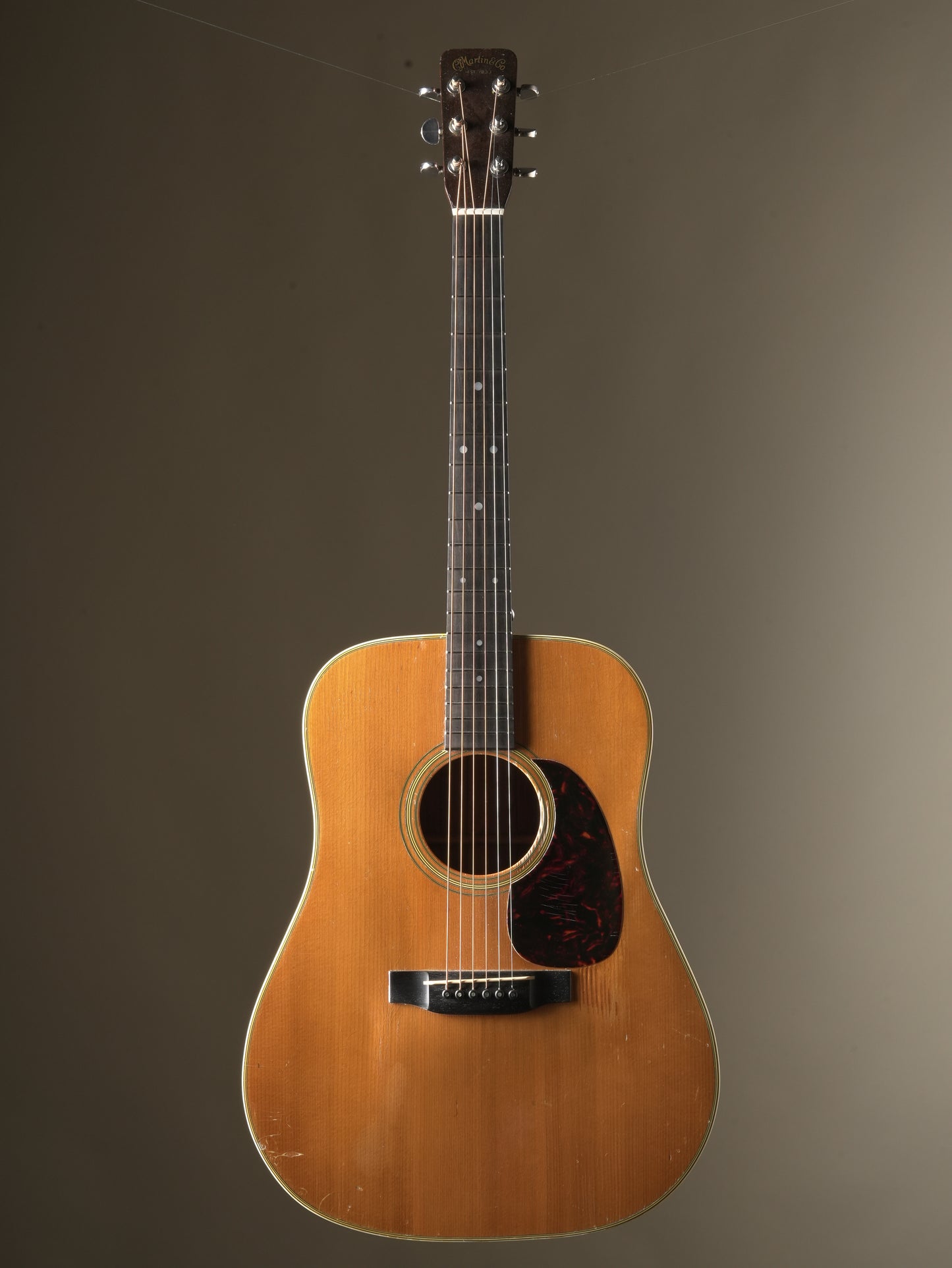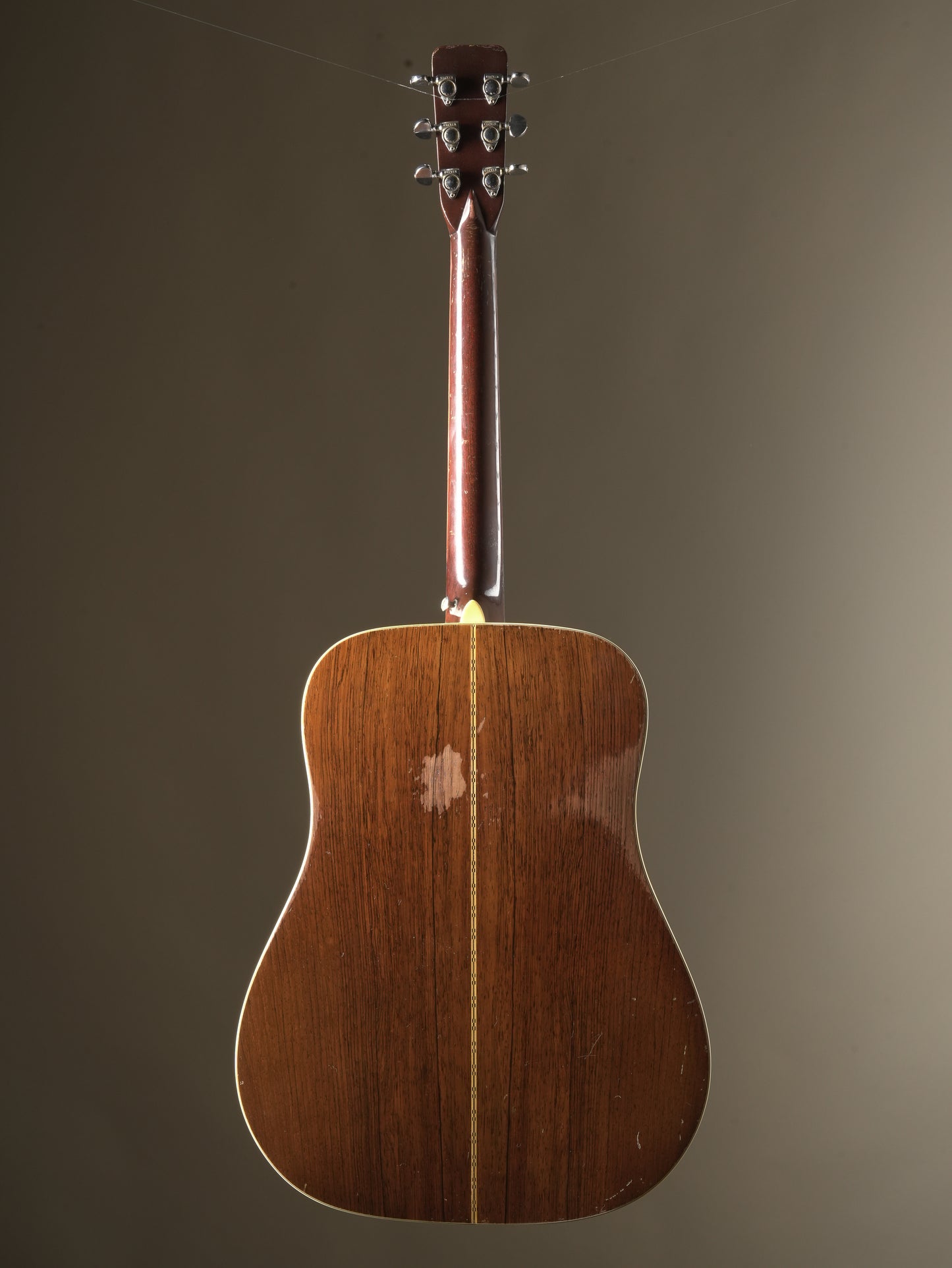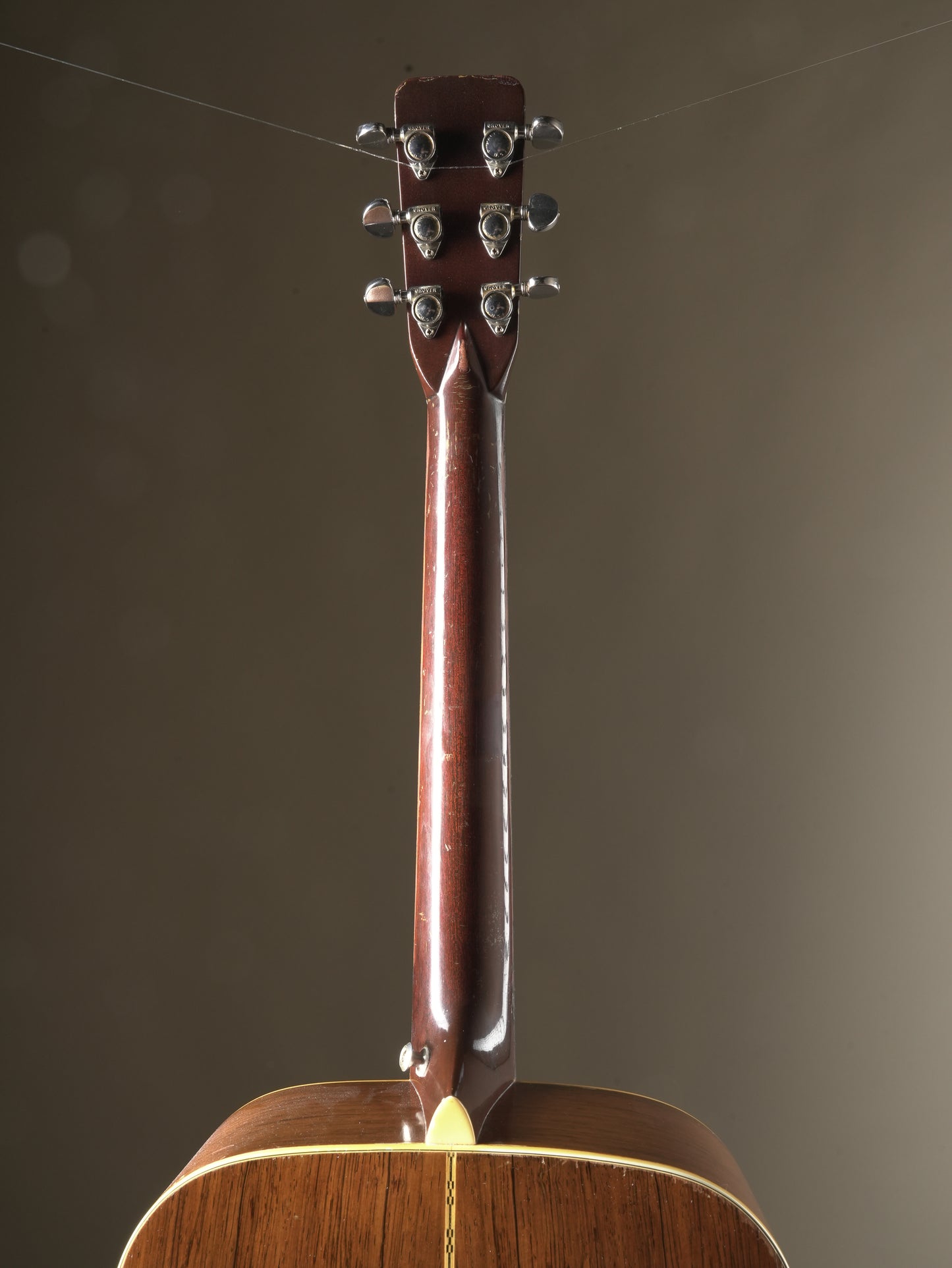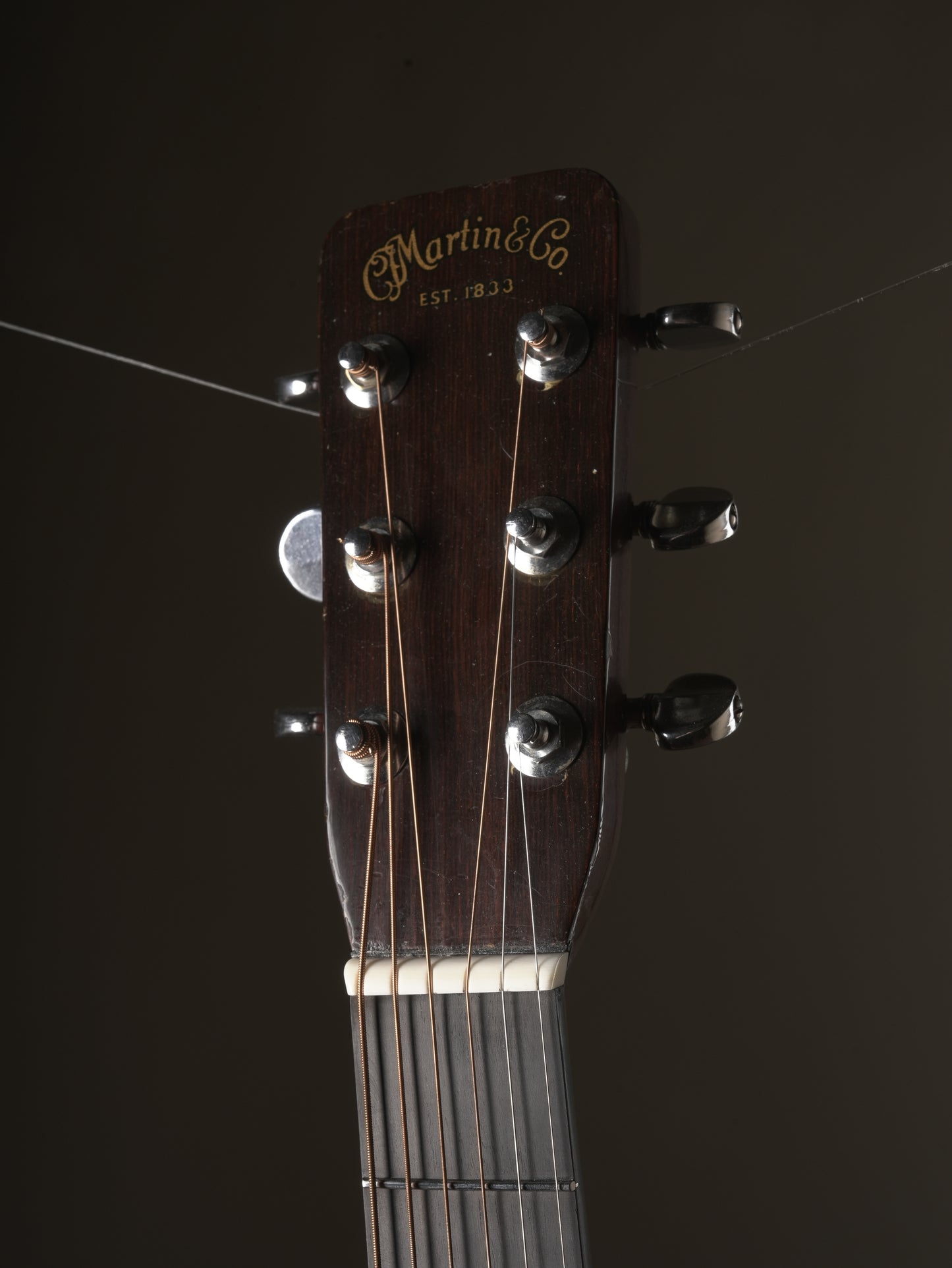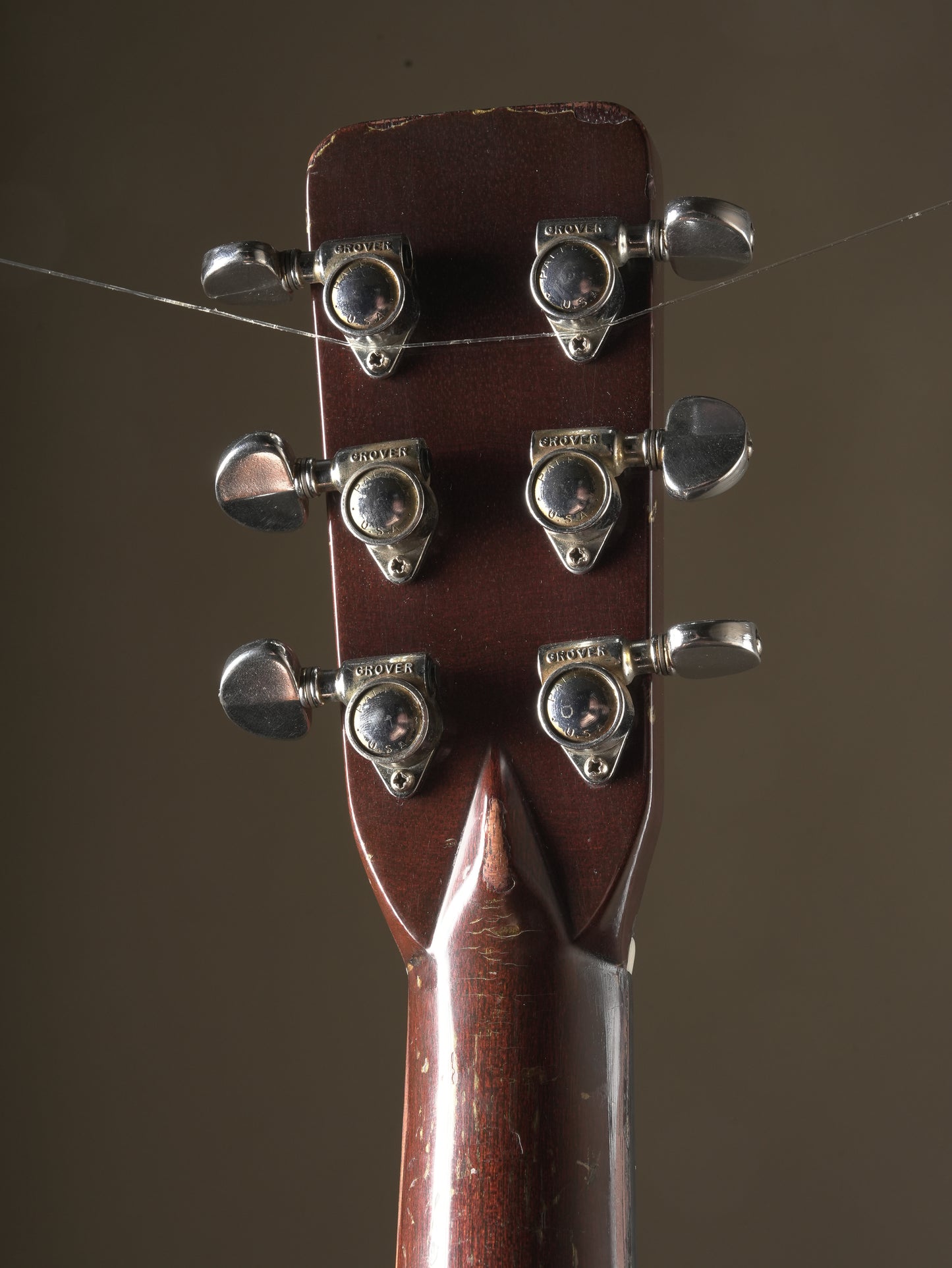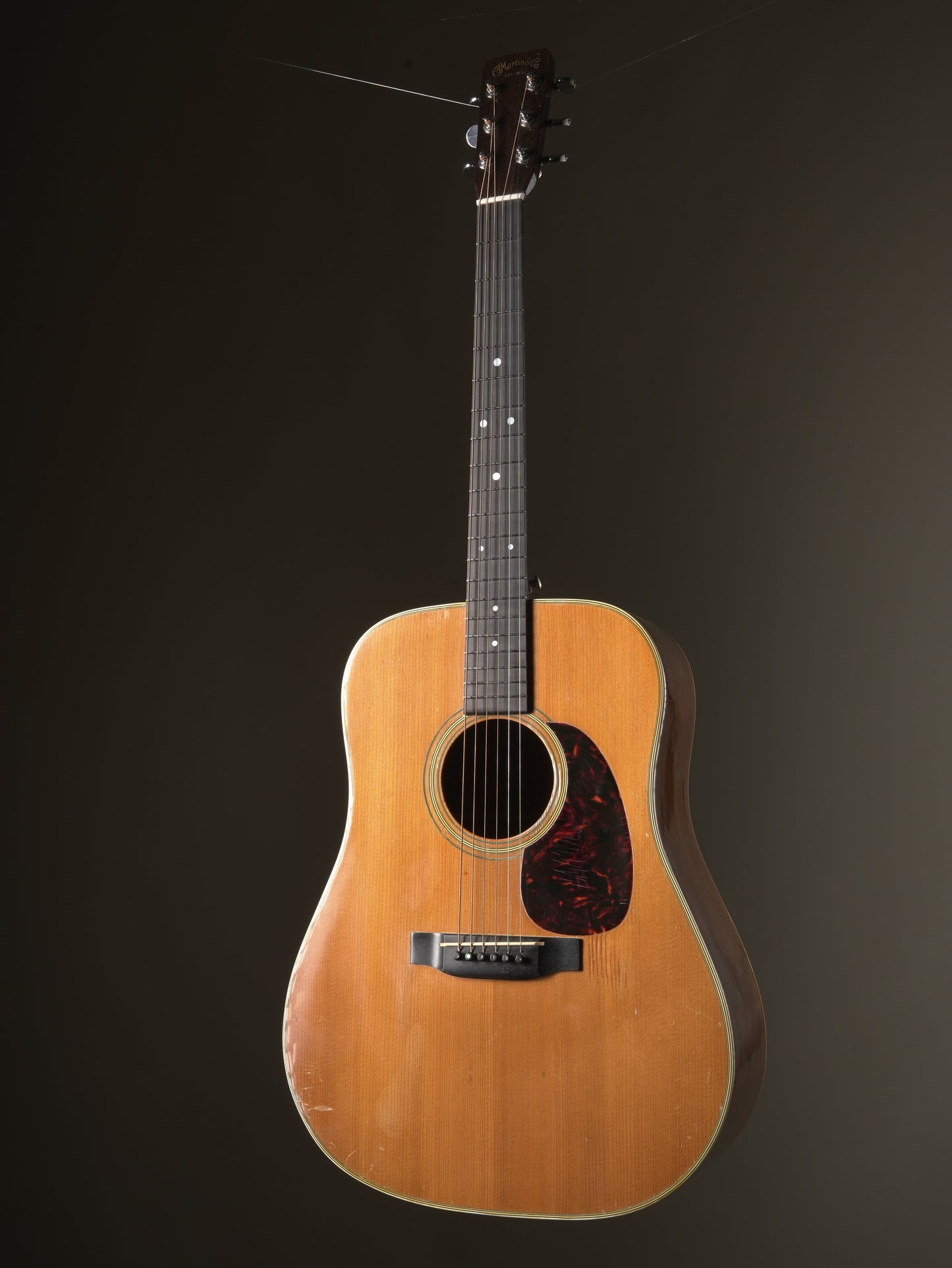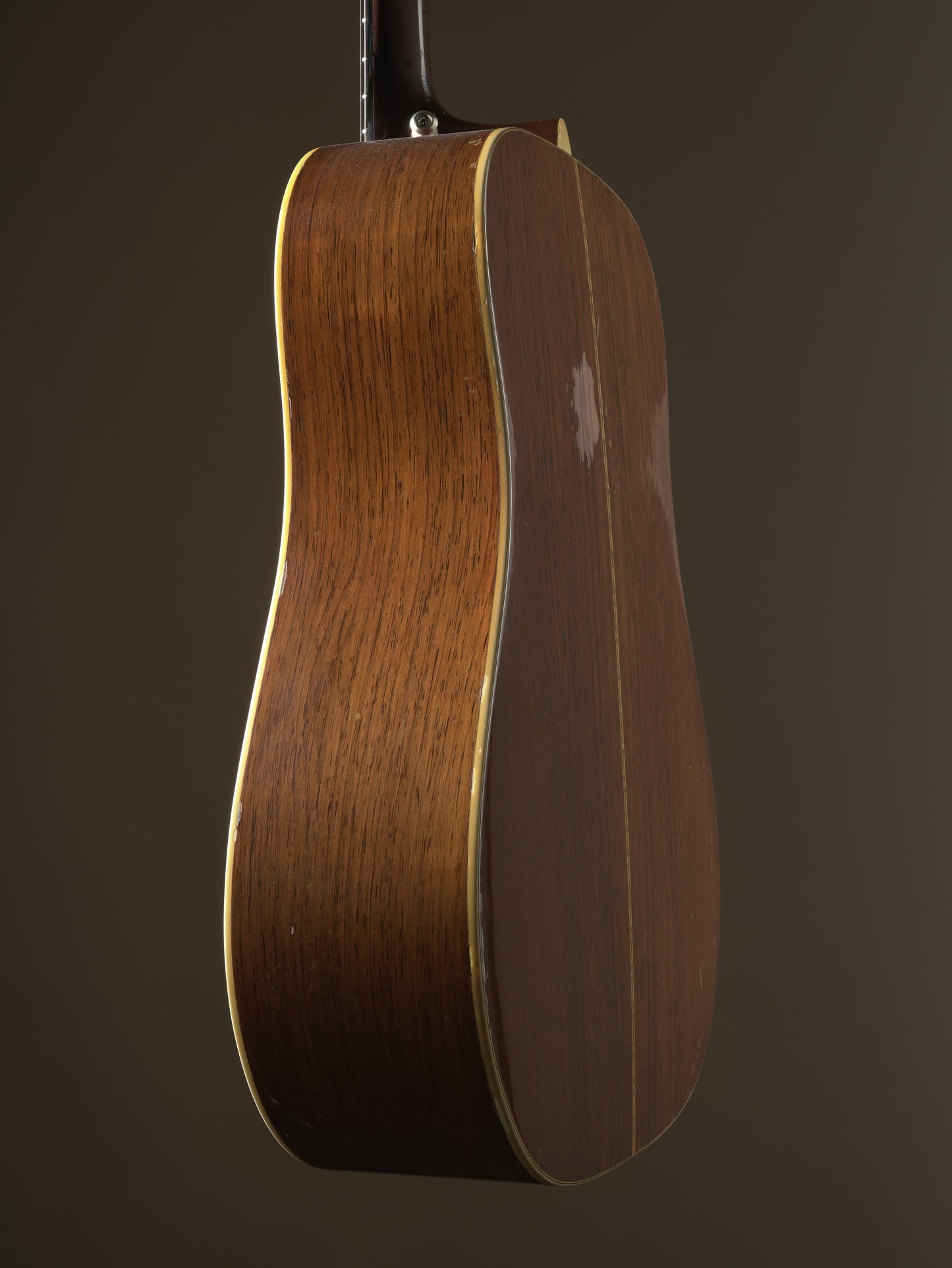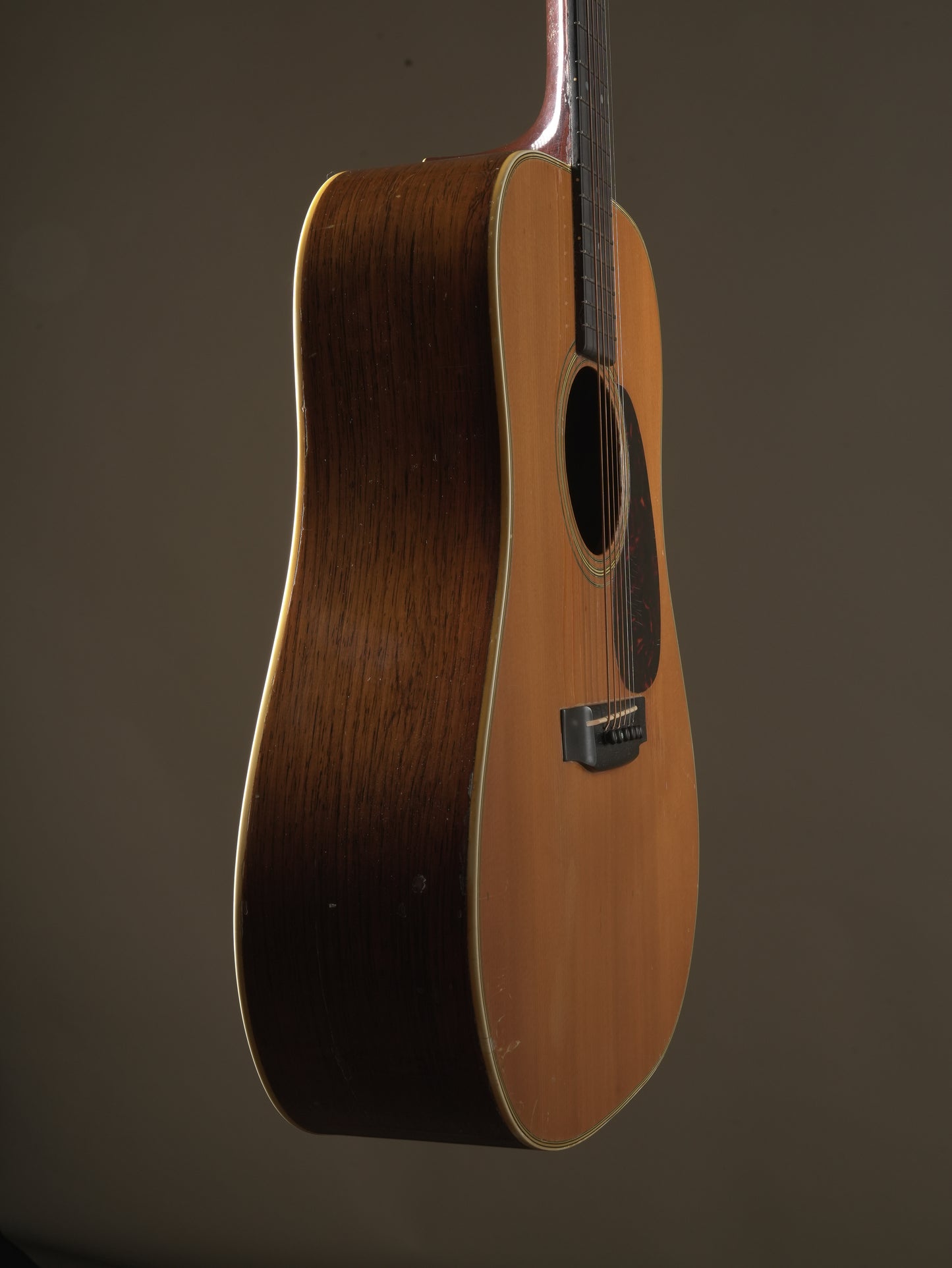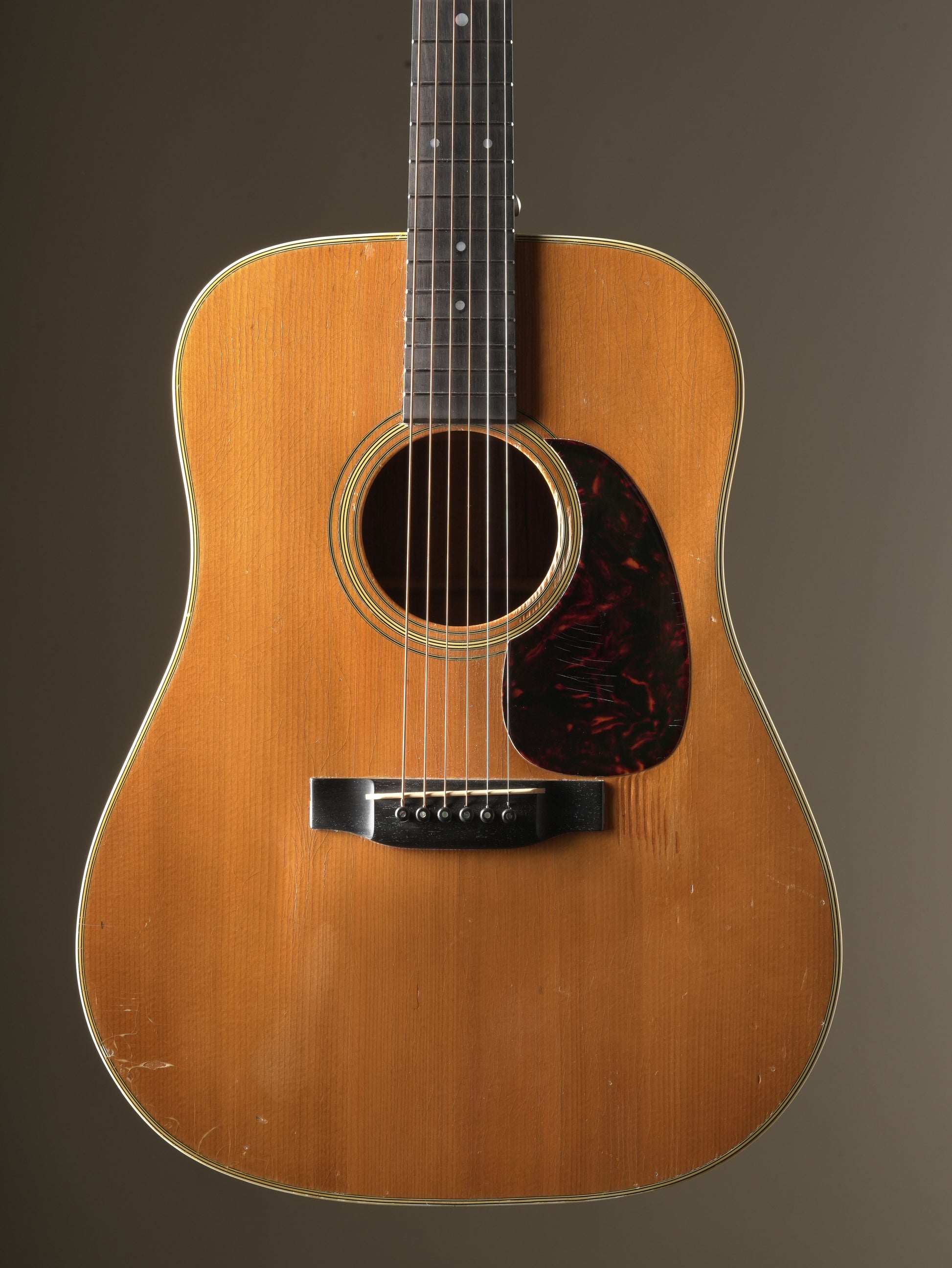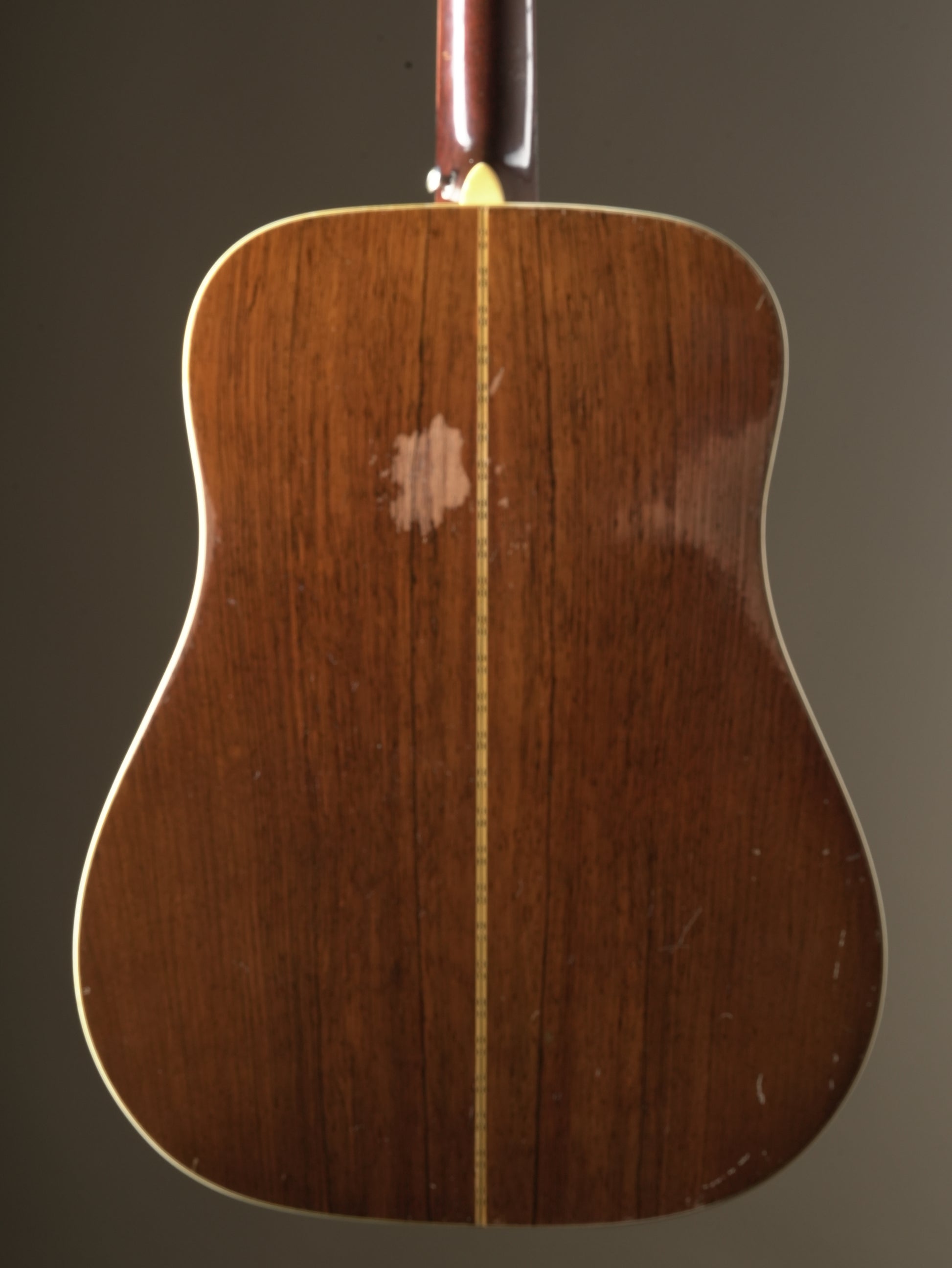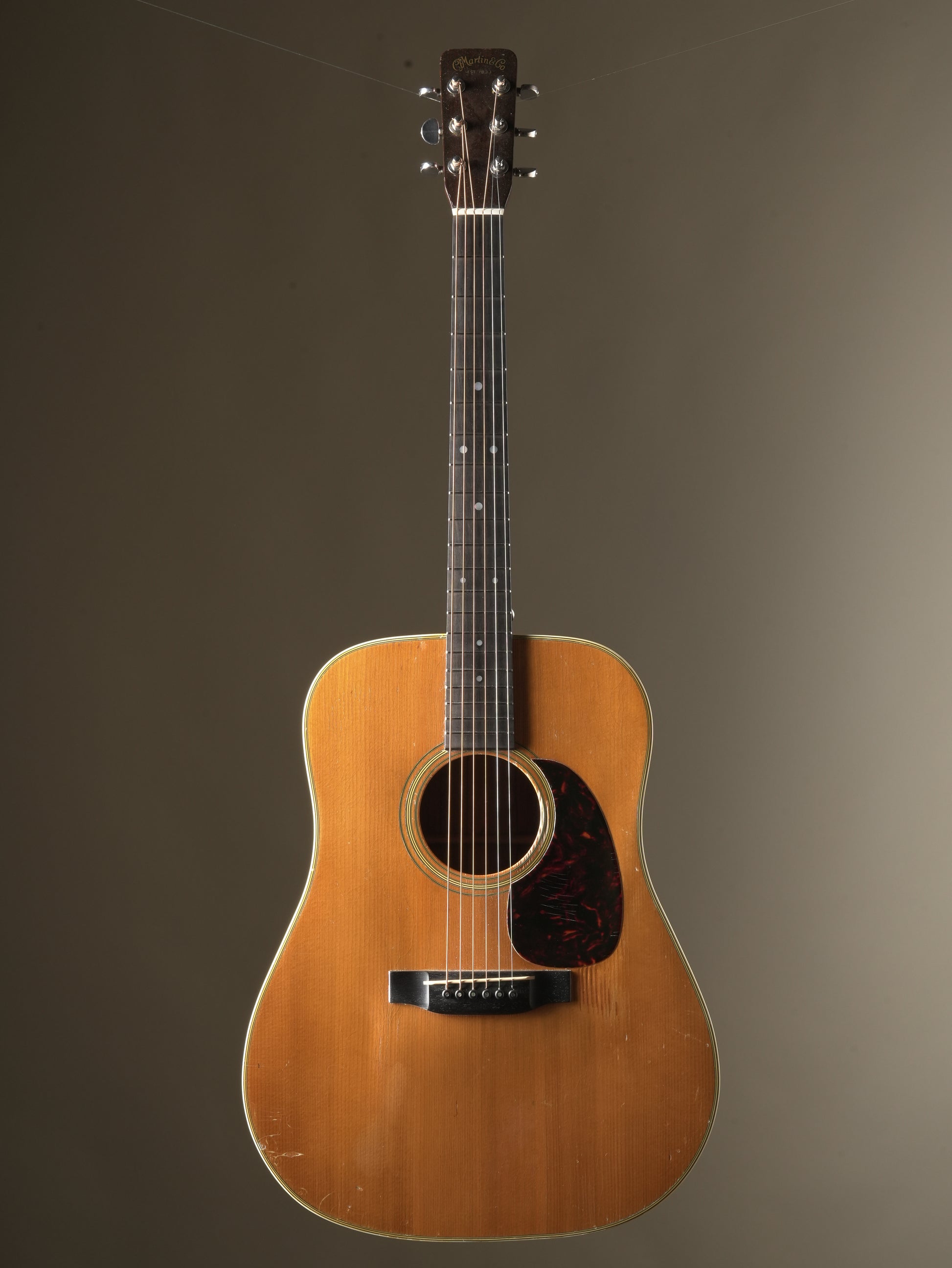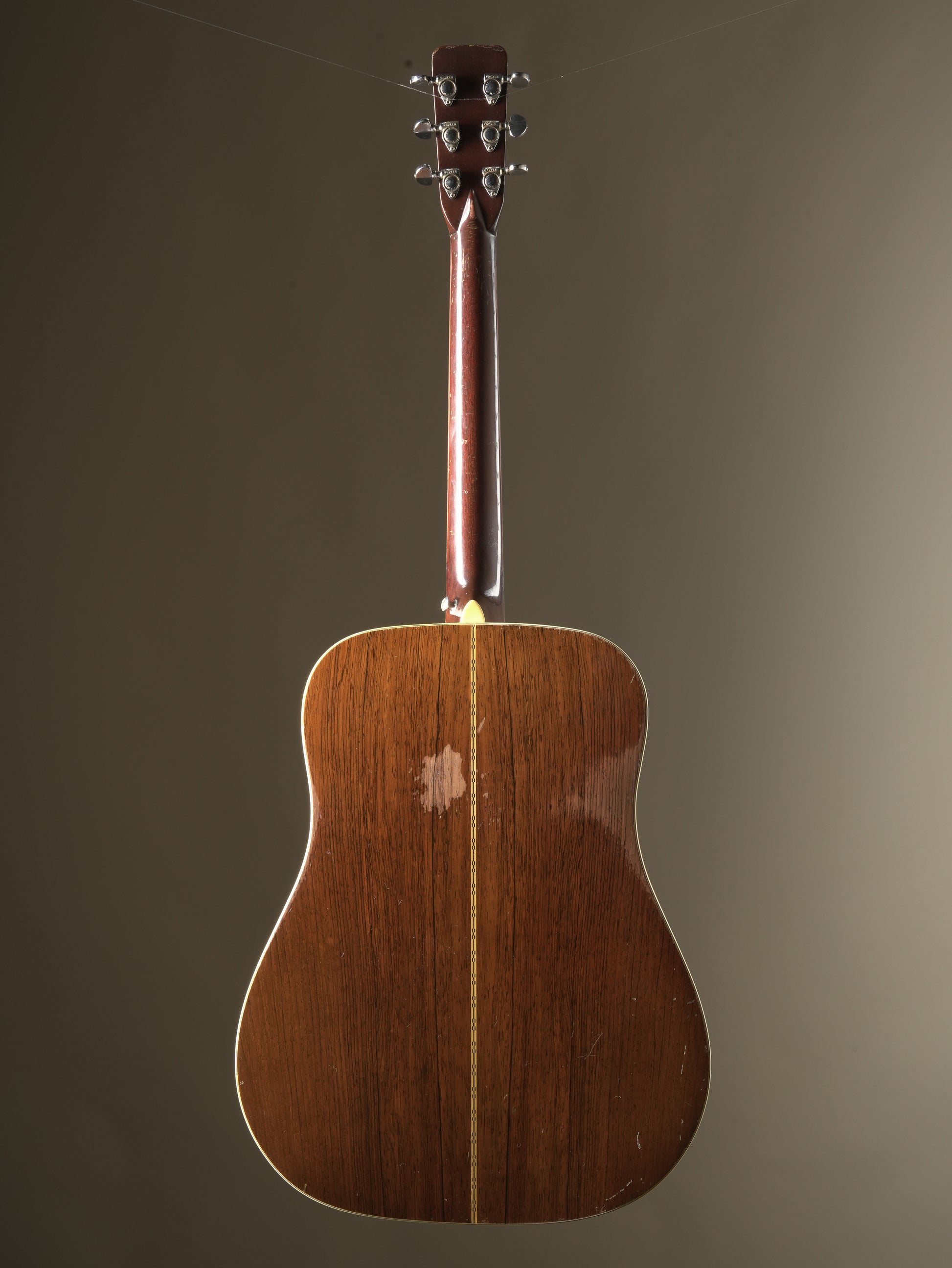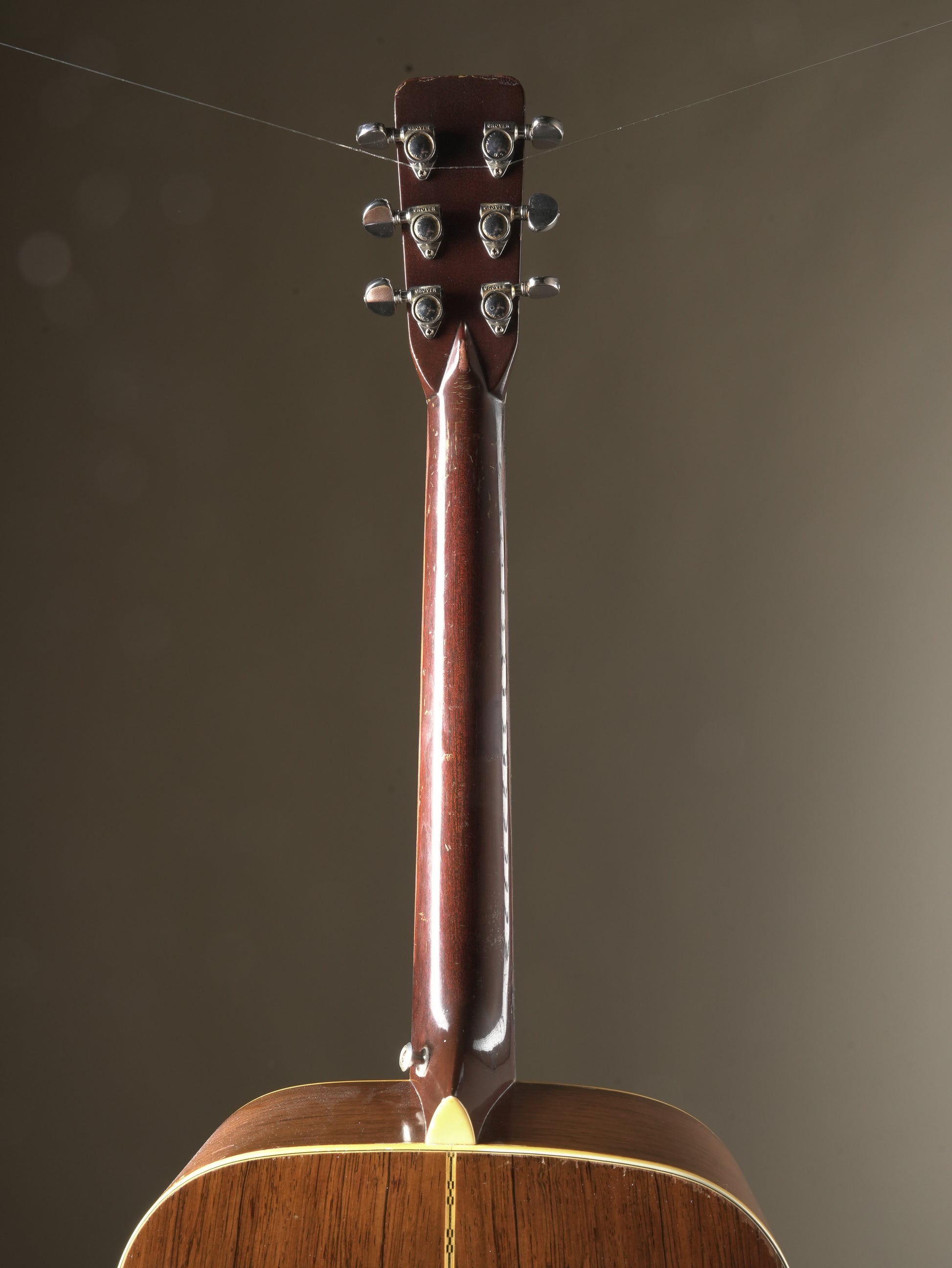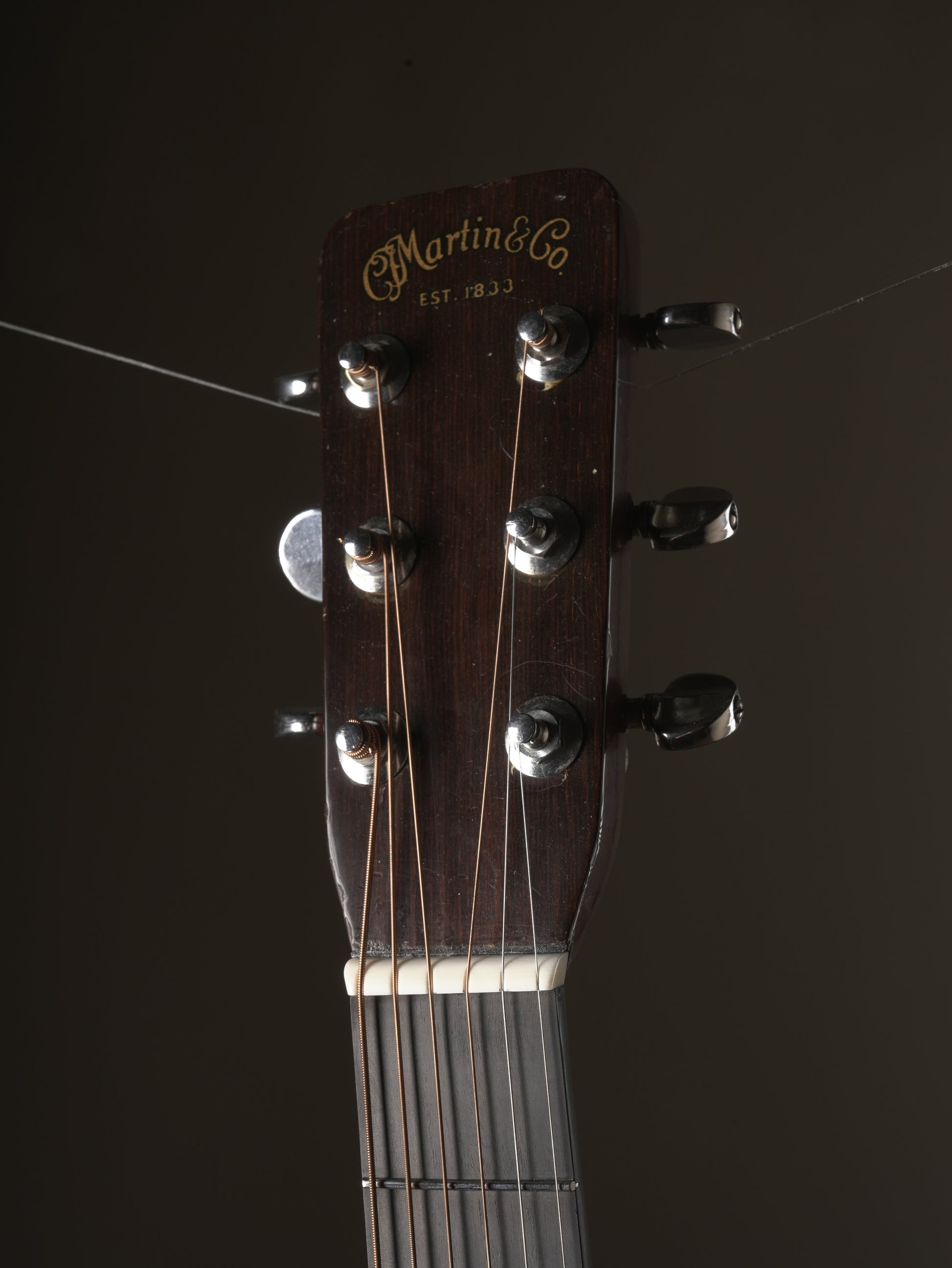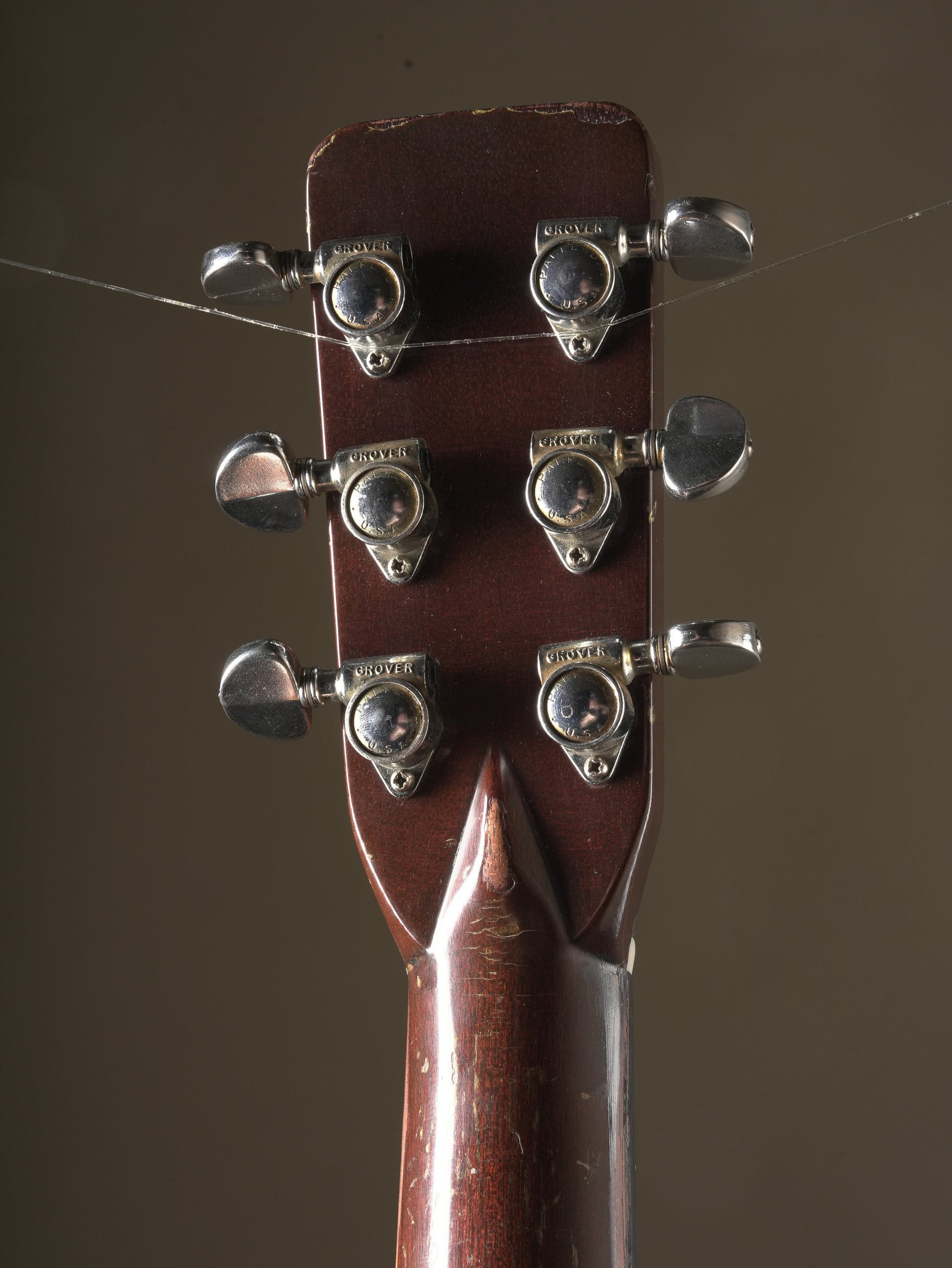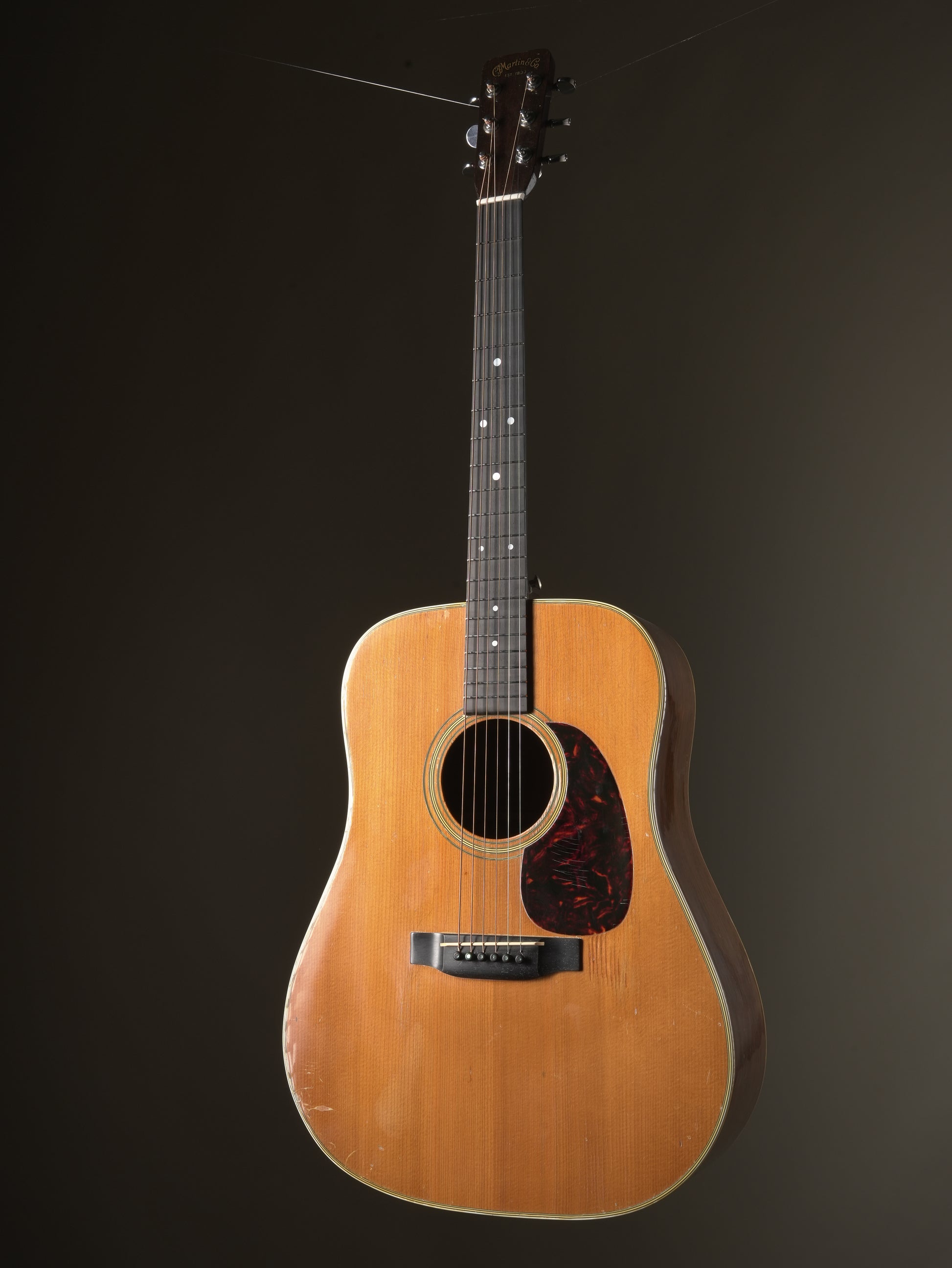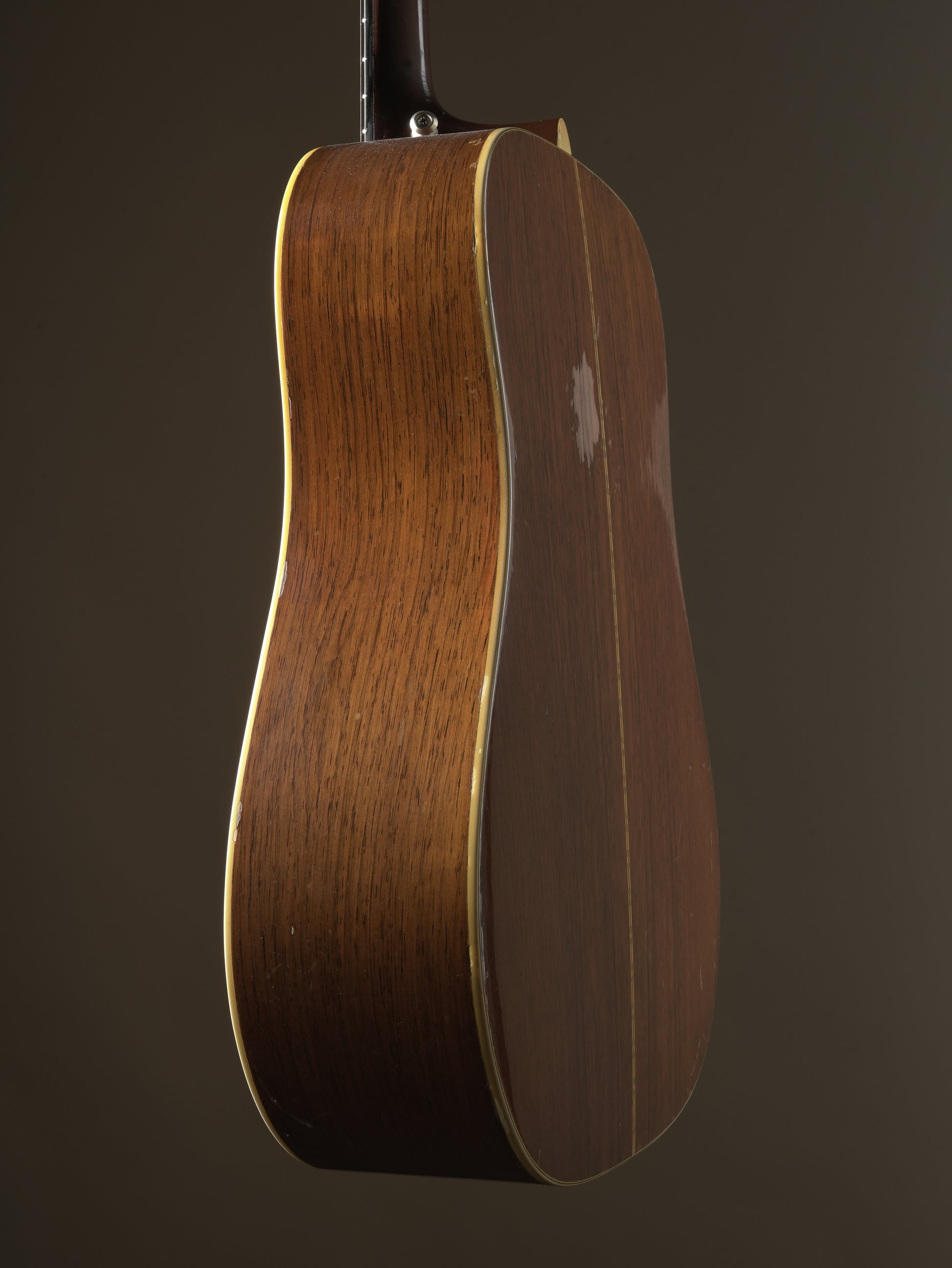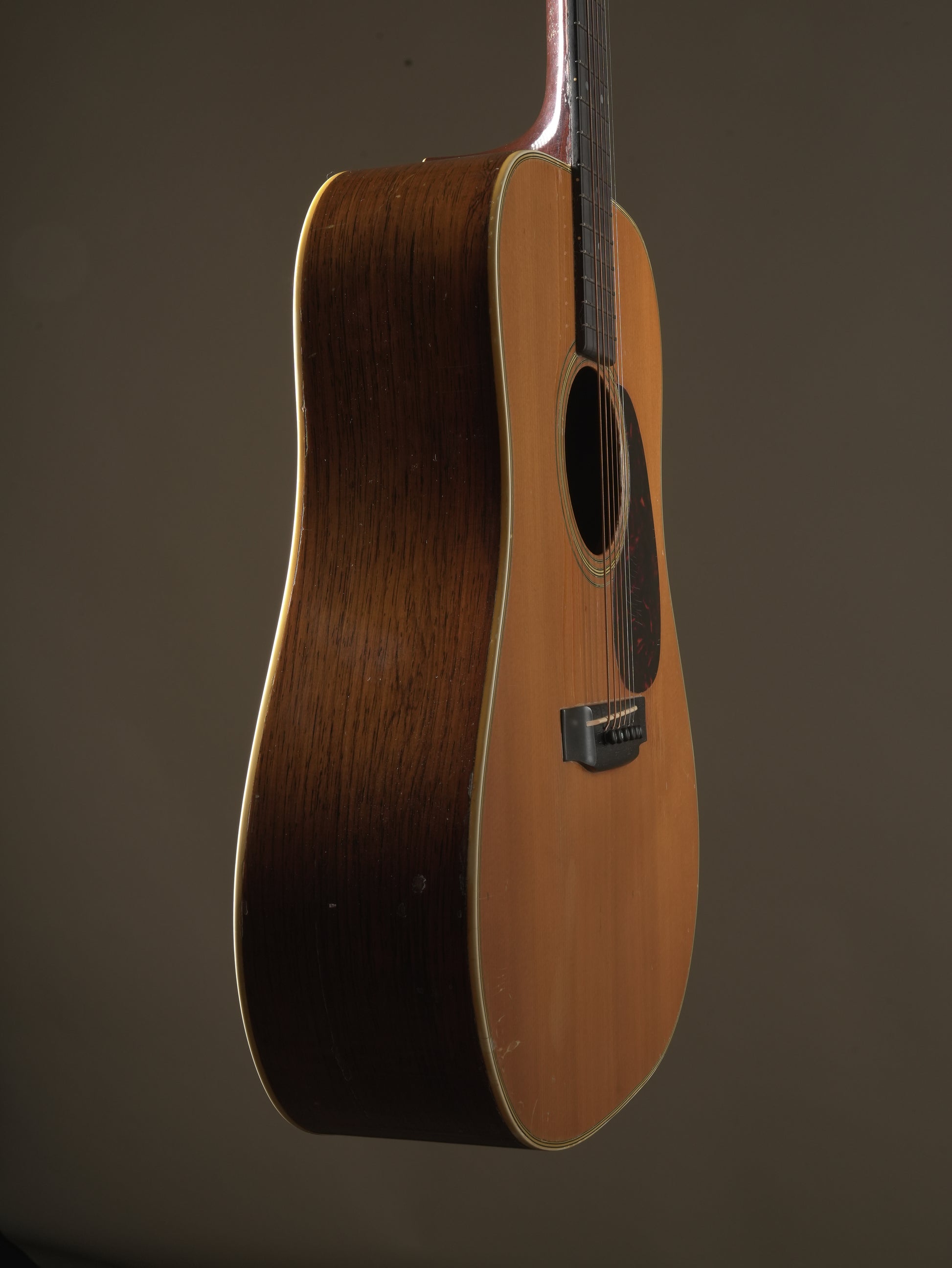Martin
Martin (1965) D-28 Acoustic Guitar - Natural, incl. HSC
Martin (1965) D-28 Acoustic Guitar - Natural, incl. HSC
Couldn't load pickup availability
1965 Martin D-28: The Final Year of the Golden Age
The 1965 Martin D-28 marks the concluding year of what is widely regarded as Martin's golden era in acoustic guitar craftsmanship. Produced during a critical phase in the company’s 132-year legacy, it predates major shifts in materials and manufacturing processes that would permanently change Martin’s tone and build. This model is the final example of the authentic "vintage" Martins, featuring old-growth Brazilian rosewood and time-honored construction methods perfected over many years.
In 1965, Martin underwent notable changes, marking the last year the company solely employed forward-shifted X-bracing, a design standard since the 1930s.
Crucially, 1965 was one of the final years Martin could source premium old-growth Brazilian rosewood. The forests that had provided Martin with outstanding tonewood for decades were becoming harder to harvest, and by the early 1970s, export restrictions would make Brazilian rosewood nearly impossible to obtain. The rosewood used in 1965 D-28 models had been air-dried for extended periods, sometimes decades, producing exceptionally stable and resonant backs and sides.
Specifications
-
Tuning Machines: Grover Tuners
-
Bridge: Ebony
-
Bridge Pins: Ebony
-
Nut and Saddle: Bone construction, hand-fitted
-
Top: Beautifully aged Sitka Spruce
-
Back and Sides: Brazilian rosewood
-
Neck: Honduran mahogany with a modified V-profile
-
Fingerboard: East Indian rosewood
-
Internal Bracing: Sitka spruce with forward-shifted X-bracing pattern
Finish Characteristics
1965 D-28s feature Martin's traditional thin nitrocellulose lacquer finish that was applied in multiple light coats. The finish shows appropriate aging, including:
-
Fine checking patterns in the lacquer
-
Natural yellowing of the top wood
-
Finish wear at contact points (armrest, pickguard area)
Body Dimensions
-
Upper Bout Width: 11.5 inches
-
Lower Bout Width: 15.625 inches
-
Body Depth: 4.875 inches at tail block
-
Scale Length: 25.4 inches
-
Nut Width: 1.75 inches (slightly wider than modern standards)
Weight and Balance
A standard 1965 D-28 weighs from 4.2 to 4.8 pounds, with differences mainly attributed to the density of its Brazilian rosewood back and sides. The forward-shifted X-bracing helps provide a somewhat more balanced weight distribution compared to subsequent models.
Neck Profile
The 1965 D-28 showcases Martin's traditional modified V-neck profile, offering a design that is thicker than contemporary C-shaped necks yet more ergonomic than the sharper V-necks of the 1930s and 1940s. Its neck thickness measures about 0.84 inches at the first fret and 0.95 inches at the 12th fret.
Fretboard Specifications
-
Radius: Very slight radius of approximately 16 inches
-
Fret Count: 14 frets clear of the body, 20 total frets
-
Fret Wire: Small vintage frets typical of the era
-
Inlay Material: Genuine abalone dots
Internal Construction
The 1965 D-28 features Martin's time-tested construction methods:
-
Bracing Pattern: Forward-shifted X-bracing with scalloped braces
-
Top Thickness: Approximately 0.110-0.120 inches
-
Back Thickness: Approximately 0.110 inches
-
Side Thickness: Approximately 0.090 inches
-
Neck Block: Solid mahogany
-
End Block: Solid mahogany with maple reinforcement
Tonal Characteristics
The 1965 Martin D-28 delivers what is widely regarded as the quintessential dreadnought tone—an ideal blend of strength, clarity, and rich musical nuance that has set the standard for steel-string acoustic guitars.
Sound Profile
The Brazilian rosewood used for the back and sides delivers a deep, intricate harmonic profile with strong low-end presence and bright treble highlights. The forward-shifted X-bracing enables the Sitka spruce top to resonate freely, creating Martin's signature bass "boom" while preserving clarity in the higher frequencies.
Dynamic Response
A standout feature of the 1965 D-28 is its exceptional dynamic responsiveness. Gentle fingerpicking yields warm, nuanced tones with clear note definition, while forceful strumming provides robust, projecting volume without sacrificing tonal intricacy. This adaptability has made it a preferred choice among both folk fingerpickers and country flatpickers.
Aging Benefits
After almost six decades, the tonewoods in a 1965 D-28 have matured to their peak resonance. The wood’s cellular structure has stabilized and crystallized, allowing for superior vibration transfer and richer harmonic complexity. Many musicians note that vintage D-28s sound more "opened up" compared to newer models.
Comparison to Other Years
The 1965 D-28 differs noticeably from later models in several ways:
-
More Complex Harmonics: Brazilian rosewood provides more overtone complexity than East Indian rosewood
-
Better Balance: Forward-shifted bracing creates better bass/treble balance than later bracing patterns
-
Superior Projection: The combination of premium woods and traditional construction provides exceptional volume and projection
-
Vintage Character: The aged tonewoods produce a woody, mature tone that new instruments cannot replicate
Hardware Specifications
-
Tuning Machines: Waverly open-gear tuners with white celluloid buttons and engraved "The Waverly Company" on the housing
-
Bridge: East Indian rosewood with a distinctive "belly" shape, secured with hide glue
-
Bridge Pins: Genuine bone or ivory (early 1965) with black dots
-
Nut and Saddle: Bone construction, hand-fitted
-
Position Markers: Small abalone dots at frets 5, 7, 9, 12, and 15
Wood Identification
-
Top: Bookmatched Sitka spruce with tight, even grain running perpendicular to the centerline
-
Back and Sides: Brazilian rosewood (Dalbergia nigra) with characteristic dark brown to purple coloring and distinctive grain patterns
-
Neck: Honduran mahogany with a modified V-profile
-
Fingerboard: East Indian rosewood (some very early 1965s may have Brazilian rosewood fingerboards)
-
Internal Bracing: Sitka spruce with forward-shifted X-bracing pattern
Finish Characteristics
1965 D-28s feature Martin's traditional thin nitrocellulose lacquer finish that was applied in multiple light coats. The finish should show appropriate aging, including:
-
Fine checking patterns in the lacquer
-
Natural yellowing of the top wood
-
Possible finish wear at contact points (armrest, pickguard area)
-
The back and sides should retain their lustrous appearance unless heavily played
Detailed Physical Specifications
Body Dimensions
-
Upper Bout Width: 11.5 inches
-
Lower Bout Width: 15.625 inches
-
Body Depth: 4.875 inches at tail block
-
Scale Length: 25.4 inches
-
Nut Width: 1.75 inches (slightly wider than modern standards)
Weight and Balance
A typical 1965 D-28 weighs between 4.2 and 4.8 pounds, with the variation largely due to the density of the Brazilian rosewood back and sides. The forward-shifted X-bracing contributes to a slightly more balanced weight distribution compared to later models.
Neck Profile
The 1965 D-28 features Martin's classic modified V-neck profile, which is fuller than modern C-shapes but more comfortable than the pronounced V-necks of the 1930s and 1940s. The neck measures approximately 0.84 inches at the first fret and 0.95 inches at the 12th fret.
Fretboard Specifications
-
Radius: Essentially flat (very slight radius of approximately 16 inches)
-
Fret Count: 14 frets clear of the body, 20 total frets
-
Fret Wire: Small vintage frets typical of the era
-
Inlay Material: Genuine abalone dots (not mother-of-pearl)
Internal Construction
The 1965 D-28 features Martin's time-tested construction methods:
-
Bracing Pattern: Forward-shifted X-bracing with scalloped braces
-
Top Thickness: Approximately 0.110-0.120 inches
-
Back Thickness: Approximately 0.110 inches
-
Side Thickness: Approximately 0.090 inches
-
Neck Block: Solid mahogany
-
End Block: Solid mahogany with maple reinforcement
Tonal Characteristics
The 1965 Martin D-28 produces what many consider the definitive dreadnought sound—a perfect balance of power, clarity, and musical complexity that has made it the template for steel-string acoustic guitars.
Sound Profile
The Brazilian rosewood back and sides provide a rich, complex harmonic structure with pronounced low-end response and sparkling treble overtones. The forward-shifted X-bracing allows the Sitka spruce top to vibrate freely, producing the characteristic Martin "boom" in the bass frequencies while maintaining clarity in the treble range.
Dynamic Response
One of the most remarkable characteristics of a 1965 D-28 is its dynamic sensitivity. Light fingerpicking produces warm, intimate tones with excellent note separation, while aggressive strumming delivers powerful, projecting volume without losing musical complexity. This versatility made these instruments favorites of both folk fingerpickers and country flatpickers.
Aging Benefits
After nearly 60 years, the tonewoods in a 1965 D-28 have reached optimal resonance. The cellular structure of the wood has settled and crystallized, resulting in improved vibration transmission and enhanced harmonic content. Many players describe vintage D-28s as having "opened up" compared to new instruments.
Comparison to Other Years
The 1965 D-28 differs noticeably from later models in several ways:
-
More Complex Harmonics: Brazilian rosewood provides more overtone complexity than East Indian rosewood
-
Better Balance: Forward-shifted bracing creates better bass/treble balance than later bracing patterns
-
Superior Projection: The combination of premium woods and traditional construction provides exceptional volume and projection
-
Vintage Character: The aged tonewoods produce a woody, mature tone that new instruments cannot replicate
Vintage Notes: respray on top, truss rod added to the guitar at some point
Share
